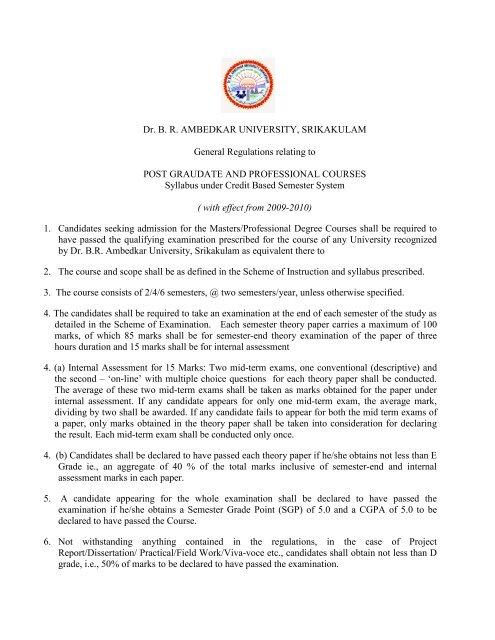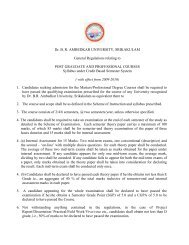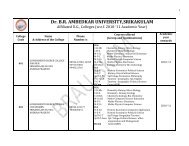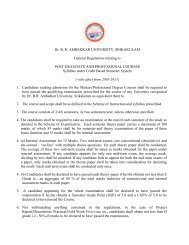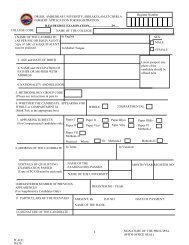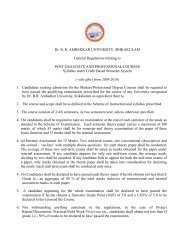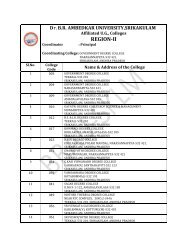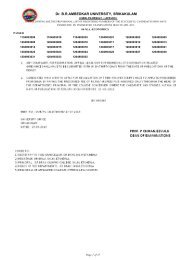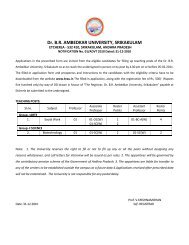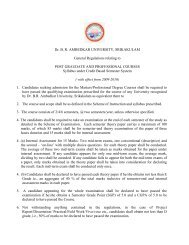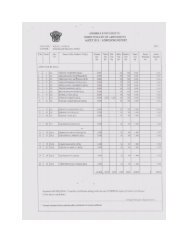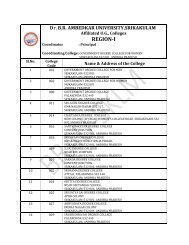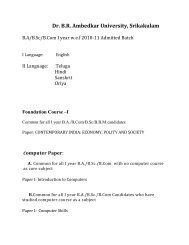M.Com - Dr.BR Ambedkar University
M.Com - Dr.BR Ambedkar University
M.Com - Dr.BR Ambedkar University
Create successful ePaper yourself
Turn your PDF publications into a flip-book with our unique Google optimized e-Paper software.
<strong>Dr</strong>. B. R. AMBEDKAR UNIVERSITY, SRIKAKULAMGeneral Regulations relating toPOST GRAUDATE AND PROFESSIONAL COURSESSyllabus under Credit Based Semester System( with effect from 2009-2010)1. Candidates seeking admission for the Masters/Professional Degree Courses shall be required tohave passed the qualifying examination prescribed for the course of any <strong>University</strong> recognizedby <strong>Dr</strong>. B.R. <strong>Ambedkar</strong> <strong>University</strong>, Srikakulam as equivalent there to2. The course and scope shall be as defined in the Scheme of Instruction and syllabus prescribed.3. The course consists of 2/4/6 semesters, @ two semesters/year, unless otherwise specified.4. The candidates shall be required to take an examination at the end of each semester of the study asdetailed in the Scheme of Examination. Each semester theory paper carries a maximum of 100marks, of which 85 marks shall be for semester-end theory examination of the paper of threehours duration and 15 marks shall be for internal assessment4. (a) Internal Assessment for 15 Marks: Two mid-term exams, one conventional (descriptive) andthe second – ‘on-line’ with multiple choice questions for each theory paper shall be conducted.The average of these two mid-term exams shall be taken as marks obtained for the paper underinternal assessment. If any candidate appears for only one mid-term exam, the average mark,dividing by two shall be awarded. If any candidate fails to appear for both the mid term exams ofa paper, only marks obtained in the theory paper shall be taken into consideration for declaringthe result. Each mid-term exam shall be conducted only once.4. (b) Candidates shall be declared to have passed each theory paper if he/she obtains not less than EGrade ie., an aggregate of 40 % of the total marks inclusive of semester-end and internalassessment marks in each paper.5. A candidate appearing for the whole examination shall be declared to have passed theexamination if he/she obtains a Semester Grade Point (SGP) of 5.0 and a CGPA of 5.0 to bedeclared to have passed the Course.6. Not withstanding anything contained in the regulations, in the case of ProjectReport/Dissertation/ Practical/Field Work/Viva-voce etc., candidates shall obtain not less than Dgrade, i.e., 50% of marks to be declared to have passed the examination.
7. ATTENDANCE: Candidates shall put in attendance of not less than 75% of attendance, out ofthe total number of working periods in each semester. Only such candidates shall be allowed toappear for the semester-end examination.7. (a) A candidate with attendance between 74.99% and 66.66% shall be allowed to appear for thesemester-end examination and continue the next semester only on medical and other validgrounds, after paying the required condonation fee.7. (b) In case of candidates who continuously absent for 10 days without prior permission on validgrounds, his/her name shall automatically be removed from the rolls.7 (c) If a candidate represents the <strong>University</strong> at games, sports or other officially organized extracurricularactivities, it will be deemed that he/she has attended the college on the days/periods8 Candidates who put in a minimum of 50% attendance shall also be permitted to continue for thenext semester. However, such candidates have to re-study the semester course only aftercompletion of the course period for which they are admitted. The candidate shall have to meetthe course fees and other expenditure.9 Candidates who have completed a semester course and have fulfilled the necessary attendancerequirement shall be permitted to continue the next semester course irrespective of whether theyhave appeared or not at the semester-end examination, at their own cost.Such candidates may be permitted to appear for the particular semester-end examination only inthe following academic year; they should reregister/ reapply for the Semester examination.The above procedure shall be followed for all the semesters10. Candidates who appear and pass the examination in all the papers of each and every semester atfirst appearance only are eligible for the award of Medals/Prizes/Rank Certificates11. BETTERMENT: Candidates declared to have passed the whole examination may reappear forthe same examination to improve their SGPA, with the existing regulations without furtherattendance, paying examination and other fees. Such reappearance shall be permitted only within 3 consecutive years from the date of first passing the final examination. Candidates who wishto appear thereafter should take the whole examination under the regulations then in vogue.12. The semester-end examination shall be based on the question paper set by an external papersetterand there shall be double valuation for post-Graduate courses. The concerned Departmenthas to submit a panel of paper-setters and examiners approved by the BOS and the Vicechancellornominates the paper-setters and examiners from the panel.13. In order to be eligible to be appointed as an internal examiner for the semester-end examination,a teacher shall have to put in at least three years of service. Relaxation of service can beexempted by the Vice-Chancellor in specific cases.14. If the disparity between the marks awarded in the semester-end examination by internal andexternal examiners is 25% or less, the average marks shall be taken as the mark obtained in the
{6(D)x4(S1)+9(A)x2(S2)+8(B)x4(S3)+7(C)x2(S4)+9(A)x4(S5)+5(E)x4(S6)+9(A)x2(S7)} 162SGPA = ------------------------------------------------------------------------------------------------------------- = ------ = 7.36{4(S1) +2(S2) +4(S3) +2(S4) +4(S5) +4(S6) +2(S7)} 22(9x2+9x4+8x4+8x4+6x2+6x4+9x2+8x4+7x2+9x4+5x4+9x2) 324CGPA = ------------------------------------------------------------------------------ = -------- = 7.71(20+22) 42a) A candidate has to secure a minimum of 5.0 SGPA for a pass in each semester in case of all PG andProfessional Courses. Further, a candidate will be permitted to choose any paper(s) to appear forimprovement in case the candidate fails to secure the minimum prescribed SGPA/CGPA to enable thecandidate to pass at the end of any semester examination.b) There will be no indication of pass/fail in the marks statement against each individual paper.c) A candidate will be declared to have passed if a candidate secures 5.0 CGPA for all PG and ProfessionalCourses.d) The Classification of successful candidates is based on CGPA as follows:i) Distinction –CGPA 8.0 or more;ii) First Class –CGPA 6.5 or more but less than 8.0iii) Second Class –CGPA 5.5 or more but less than 6.5iv) Pass –CGPA 5.0 or more but less than 5.5e) Improving CGPA for betterment of class will be continued as per the rules in vogue.f) CGPA will be calculated from II Semester onwards up to the final semester. CGPA multiplied by “10” givesaggregate percentage of marks obtained by a candidate.
ANNEXURE – IIMaster of <strong>Com</strong>merce (M.<strong>Com</strong>.)SCHEME OF INSTRUCTIONFirst Semester:____________________________________________________________________________________Course Title of the Paper <strong>Com</strong>pulsory No. of Periods ofNo.instruction per Week101 MANAGEMENT THEORY AND PRACTICE <strong>Com</strong>pulsory 5102 INDIAN BUSINESS ENVIRONMENT <strong>Com</strong>pulsory 5103 ADVANCED MANAGEMENT ACCOUNTING <strong>Com</strong>pulsory 5104 BUSINESS ECONOMICS <strong>Com</strong>pulsory 5105 BUSINESS COMMUNICATIONS <strong>Com</strong>pulsory 5106 SOFTSKILLS – I (Business and Spoken English) <strong>Com</strong>pulsory 5____________________________________________________________________________________Second Semester:____________________________________________________________________________________Course Title of the Paper <strong>Com</strong>pulsory No.of Periods ofNo.instruction per Week____________________________________________________________________________________201 QUANTITATIVE TECHNIQUES FOR BUSINESS DECISIONS <strong>Com</strong>pulsory 5202 IT for Business <strong>Com</strong>pulsory 5203 FINANCIAL MANAGEMENT <strong>Com</strong>pulsory 5204 HUMAN RESOURCE MANAGEMENT <strong>Com</strong>pulsory 5205 MARKETING MANAGEMENT <strong>Com</strong>pulsory 5206 SOFTSKILLS – II <strong>Com</strong>pulsory 5____________________________________________________________________________________
Annexure - IIIScheme of Examination as per Credit SystemFirst Semester:Course No.Title of the PaperCredit PointsMax.Marks.Double Valuation(Internal + External)Internal Assessment101 MANAGEMENT THEORY AND PRACTICE 4 100 8 85 1 15102 INDIAN BUSINESS ENVIRONMENT 4 100 8 85 1 15103 ADVANCED MANAGEMENT ACCOUNTING 4 100 8 85 1 15104 BUSINESS ECONOMICS 4 100 8 85 1 15105 BUSINESS COMMUNICATIONS 4 100 85 15106 SOFTSKILLS – I (Business and Spoken English) 4 100 85 15Total 24 600 510 7 90
Second Semester:CourseNo.Title of the PaperCredit PointsMax.Marks.Double Valuation (Internal +External)201 QUANTITATIVE TECHNIQUES FOR BUSINESS DECISIONS 4 100 8 85 1 15202 IT for Business 4 100 8 85 1 15203 FINANCIAL MANAGEMENT 4 100 8 85 1 15204 HUMAN RESOURCE MANAGEMENT 4 100 8 85 1 15205 MARKETING MANAGEMENT 4 100 4 85 5 15206 SOFTSKILLS – II (Personality Development & Group discussion) 4 100 4 85 5 15Total 24 600 510 90Internal Assessment
Third Semester:CourseNo.Title of the PaperCredit PointsMax.Marks.Double Valuation(Internal + External)Internal Assessment301 Insurance Products & Management 4 100 85 15302 Corporate Accounting (Accounting) 4 100 85 15303 International Accounting (Accounting) 4 100 85 15304 Direct Taxes (Taxation) 4 100 85 15305 Indirect Taxes (Taxation) 4 100 85 15Total 20 500 425 7 75
Fourth Semester:CourseNo.Title of the PaperCredit PointsMax.Marks.Double Valuation (Internal +External)Internal Assessment401 <strong>Com</strong>puter Applications in Accounting (Tally) 4 100 8 85 15402 Strategic Cost Management (Accounting) 4 100 8 85 15403 Management Control Systems (Accounting) 4 100 85 15404 WAT and Service Tax (Taxation) 4 100 85 15405 Tax Planning and Management (Taxation) 4 100 85 15406 Project Work 4 100 100 7 --Viva -voce -- 100 100* --Total 24 700 625 75* Single Valuation by Viva-Voce committee.Total Marks:- First, Second, Third & Fourth Semesters put together: 600+600+500+700 = 2400Total Credits:- First, Second, Third & Fourth Semesters put together: 24+24+20+24 = 88
<strong>Dr</strong>. B.R. <strong>Ambedkar</strong> <strong>University</strong>, SrikakulamM.<strong>Com</strong>SyllabusSemester I101: MANAGEMENT THEORY AND PRACTICEObjectives: The objective of this paper is to familiarise the students with basicmanagement concepts and the process of organisation.Unit – I: Introduction: Concept of Management: Definition, Nature, Purpose, Scope andSignificance – Evolution of Management Thought – Approaches to Management – Process ofManagement – External Environment Functions of Management.Unit – II: Planning: Types of Plans – Objectives, Management by Objectives, PlanningPremises Decision Making: Decision Making Process – Decision Tree Analysis – LinearProgramming, Game Theory.Unit – III: Organisation: Principles of Organization: Formal and Informal Organisation –Span of Control – Delegation of Authority – Centralisation and Decentralization – Line and StaffConflict and Cooperation. Staffing Process The nature and Purpose of Staffing – ExecutiveDevelopment Programme (EDPs).Unit – IV: Directing: Elements of Directing <strong>Com</strong>munication – Importance, Process,Media, Barriers to <strong>Com</strong>munication. Effective <strong>Com</strong>munication. Motivation – Leadership –Concept, Styles, Theories – Managerial Grid: Lickerts Four Systems of Leadership.Unit – V: Process of Control, Techniques of control, PERT and CPM.Suggested Books:1. James A. F. Stoner, R. Edward Freeman and Danirl R. Gilbirt Jr. – Management,Prentice Hall of India.2. Heinz Weihrich and Harold Koontg, Essentials of Management – Tata McGraw HillInternational.3. Stephen Robbins and Mary Coulter, Management, Prentice Hall of India.4. Bajaj: Management Processing and Organization, Excel Publications.5. Tripathy and Reddy – Principles of Management – Tata McGraw Hill.6. John F. Wilson – The Making of Modern Management, Oxford <strong>University</strong> Press.7. Heiny Weihrich and Harold Koonty – Management, A Global Perspective – McGrawHill International.8. R.K. Suri, Organizational Behaviour, Wisdom Publication.9. A. Pardhasardhy & R. Satya Raju: Management Text and Cases, Prentice Hall ofIndia.
Semester I102: INDIAN BUSINESS ENVIRONMENTObjective: to familiarize the students with the business environment conditions prevailing inIndia and international and understand its implications to business.Unit-I Business Environment: <strong>Com</strong>ponents and Significance – Economic Scope – Cultural,Political, Technological and External Factors Influencing Business Environment – Dimensionsof International Business Environment – Challenges.Unit-II: Structure of Indian Economy ; Economic systems- Economic planning with specialreference to last three plans, public, private joint and cooperative sectors - Industrial Policy ofthe Government - Policy Resolutions of 1956, 1991 Industrial Policy and Economic Policy -Subsequent policy StatementsUnit-III Indian <strong>Com</strong>panies -<strong>Com</strong>petitiveness, Changes and Challenges, SustainableDevelopment, Social Responsibilities, Ethics in Business- <strong>Com</strong>petition Act 2002 - EmergingTrend in Indian Business Environment.Unit – IV: International Trade Theories, Balance of Payments – Concepts, Disequilibrium inBOP Structural, Cyclical and Monetary Disequilibrium, Methods of Correction, Trade Barriersand Trade Strategy - Free Trade vs. Protection -World Financial Environment – ForeignExchange Market Mechanism, Exchange Rate Determination, Euro Currency.Unit – V: Globalisation: International Economic Integration, Country Evaluation and Selection,Foreign Market Entry Methods, International Trade Stocks – Their Objectives; WTO Origin,Objectives, Organisation Structure and Functioning – WTO and India.Suggested Books:1. K.V.Sivayya and VBM Das: Indian Industrial Economy, Sultan Chand Publishers, Delhi.2. Suresh Bedi: Business Environment, Excel, New Delhi.3. Francis Cherunilam: Business Environment - Text & Cases4. M.Adhikari, Economic Environment of Business.5. Pandey G.N., Environmental Management, Vikas Publishing House.6. Raj Agarwal: Business Environment, Excel Publications.7. Govt. of India, Latest Economic Survey.8. Chari, S, N: International Business, Wiley India9. Francis Cherunilam: International Business: Text and Cases, Prentice Hall of India.10. E. Bhattacharya: International Business, Excel Publications.11. Sundaram & Black: International Business Environment Text and Cases, PHI.12. Sajahan: International Business, Mac-Milan India. New Delhi.
Semester I103: ADVANCED MANAGEMENT ACCOUNTINGObjective: The basic purpose of this course is to develop an insight of postulates,principles and techniques of accounting and utilisation of financial and accounting informationfor planning, decision-making and control.Unit – I: Management Accounting – Nature and Scope – Management Accounting VsFinancial Accounting and Cost Accounting – Role of Management Accountant in a ModernOrganisation.Unit – II: Cost Concepts for Decision Making - Cost – Volume – Profit Analysis –Behaviour of Variable Cost – Behaviour of Fixed Cost – Relationships Among Cost and Profitsat Various Levels of Activity – Break-Even Point – Margin of Safety – Contribution Approachfor Decision Making – Analysis of Contribution Per Unit of Critical Factor.Unit – III: Cost Analysis for Pricing Decisions – Evaluating the cost Effects of Price –Quantity Relationships Price Elasticity of Demand and Optimal Pricing Decisions – CostAnalysis for Pricing During Recession Conditions – Flexible Cost Data for Pricing Decisions –Special Order Pricing – Impact of Special Order Pricing on Regular Sales and Overall Profits –Partial Fulfilment of Special Order Vs Outsourcing Decisions – Make or Buy Decisions.Unit – IV: Cost Analysis for Product Decisions – Breakeven Analysis of Multi-ProductFirms – Differential Costs for Product – Mix Alterations Decisions – Product Additions Decision– Adding New Products <strong>Com</strong>bining Pricing Decisions with Product Addition Decision andSelecting Profitable Product-Price Strategies – Produce Deletion – Sell or Process FurtherDecision of Joint and By-Products.Unit – V: Budgeting – Types of Budgets – Financial Budgets – Operating Budgets –Cash Budget – Production Budget – Flexible Budget – Concepts of Performance Budgeting andZero Based Budgeting.Suggested Books:1. I.M. Pandey: Management Accounting, Vikas Publishing House.2. N.M. Singhvi, Management Accounting: Text and Cases, Prentice Hall ofIndia.3. T.P. Ghosh: Fundamentals of Management Accounting, Excel Publications.4. Ravi M. Kishore, Management Accounting, Taxman Publications.5. Chakraborty, Hrishikesh – Management Accountancy, Oxford <strong>University</strong>Press.6. Horngren, C.T., Introduction to Management Accounting, Prentice Hall ofIndia.7. Khan and Jain, Management Accounting, Tata McGraw Hill, Delhi.8. J.C. Varshney: Financial and Management Accounting, Wisdom Publication.9. Horngren Sundem Stratton, Management Accounting, Prentice Hall of India.10. Paresh P. Shah, Management Accounting, Wiley India, New Delhi.
Semester I104: BUSINESS ECONOMICSObjective: The objective of this course is to enable the students to understand economicconcepts and theories and their application in management decision-making.UNIT I: Introduction: Nature and Scope of Business Economics; Objectives of the Firm –Traditional Theory, Sales and Revenue Maximizing Theories, Managerial Theories andBehavioual Theories; Profit Maximization Vs. Wealth Maximization; Demand Forecasting –Methods for Existing and New Products, Criteria for Good Forecasting Method.UNIT II: Production Analysis and Cost Analysis: Production Function – Law of VariableProportions, Isoquant and Isocost Curves, Least Cost <strong>Com</strong>bination, and Returns to Scale;Economies of Large Scale; Cobb-Douglas Production Function and C.E.S. Production Function;Cost-Output Relationships – Short and Long Run; Cost Oriented Pricing Methods – Full CostPricing, Marginal Cost and Differential Costing.UNIT III: Market Analysis: Price and Output Determination Under Perfect <strong>Com</strong>petition,Monopoly, Monopolistic <strong>Com</strong>petition, Oligopoly and Duopoly.UNIT IV: Profit Analysis: Meaning of Profit, Limiting Factors of Profit, Criteria forStandard Profit: Theories of Profit; Business Forecasting – Nature of Scope of Forecasting andDifferent Methods of Business Forecasting and their Advantages and Disadvantages.UNIT V: Macro Economic Concepts: National Income, Trade Cycles, Inflation, andMonetary and Fiscal Policies.Suggested Books:1. Mukherjee Sampat: Business and Managerial Economics (In the Global Context), ThirdEdition, New Central Book Agency (P) Ltd., Kalkota, 1996.2. Dwivedi, D.N.: Managerial Economics, Vikas Publishing House Pvt. Ltd., 20033. Dhingra, I.C., Essentials of Managerial Economics; Theory, Applications and Cases,Sultan Chand, New Delhi, 2003.4. Mithani, D.M.: Managerial Economics; Theory and Applications, Himalaya PublishingHouse, 2003.5. Mehta, P.L.: Managerial Economics, Text and Cases, S.Chand & Co., Delhi6. Varshney, R.L. and Maheswari, K.L.: Managerial Economics, S.Chand & Co, Delhi7. Dwivedi, D.N.: Macroeconomics; Theory and Policy, Tata McGraw Hill Publishing<strong>Com</strong>pany, 2002.8. Gupta, G.S.: Macroeconomics; Theory and Applications, Tata McGraw Hill Publishing<strong>Com</strong>pany Ltd.\9. Yogesh Maheswari, Managerial Economics, 2 nd Edition, Prentice Hall of India.
Semester I105: BUSINESS COMMUNICATIONSObjective: The course is aimed at equipping the students with the necessary techniquesand skills of communication to inform others, inspire them enlist their activity and willingcooperation in the performance of their jobs.Unit – I: Importance of <strong>Com</strong>munications in Business Organisations – <strong>Com</strong>municationObjectives – Media of <strong>Com</strong>munication: Written, Oral, Visual – Audio Visual <strong>Com</strong>munication.Unit – II: Interpersonal <strong>Com</strong>munication – Interpersonal <strong>Com</strong>munication –<strong>Com</strong>munication Models: Exchange Theory – Johari Window – Transactional Analysis,<strong>Com</strong>munication Styles.Unit – III: <strong>Com</strong>munication Barriers – <strong>Com</strong>munication Gateways – Developing ListeningSkills – Influence of Culture on <strong>Com</strong>munication.Unit – IV: Report Writing – Formal Reports – Informal Reports – Writing Good Newsand Bad News.Unit – V: Meetings and Oral Presentations – <strong>Com</strong>munication Through Visuals – Use ofElectronic Media in Business <strong>Com</strong>munication.Suggested Books:1. Jerry C. Wofford, Edwin A. Gerloff and Robert C. Cummins, Organisational <strong>Com</strong>munication– The Key stone of Managerial Effectiveness.2. McGrath, Basic Managerial Skills for All, 5 th ed., Prentice Hall of India.3. Urmila Rai & S.M. Rai, Business <strong>Com</strong>munication, Himalaya Publishers, Mumbai.4. Meenakshi Raman – Business <strong>Com</strong>munication, Oxford <strong>University</strong> Press.5. Bovee, Thill and Schatzman: Business <strong>Com</strong>munication Today: Pearson Education.6. Biswajit Das: Business <strong>Com</strong>munication personality Development, Excel Publications.7. Parag Diwan: Business <strong>Com</strong>munication, Excel Publications.8. Lesikar I Flatley, Basic Business <strong>Com</strong>munication, Tata McGraw Hill.9. Dalmar Fisher, <strong>Com</strong>munication in Organizations, A Jaico Book.10. Scot Ober, Contemporary Business <strong>Com</strong>munication, Wiley India, New Delhi.***
Semester I106: SOFTSKILLS – I (Business and Spoken English)Objective: to train students in English language to improve their oral and written businesscommunicationUnit-I : Business Correspondence: Meaning, Scope and Significance - Formal, informal andsemi-formal introductions – Describing company activities and structures – Describing jobresponsibilities - Understanding and writing letters - Differences between formal andinformal writing – Use of formal vocabulary and functional language in business letterwriting – Planning effective initial business letters and responses – email writing skills, calltaking etiquette/skills.Unit-II : Business Information: <strong>Com</strong>pleting forms with required details: Asking appropriatequestions to gather information – Polite phrases of confirmation and communicationbreakdown- understanding native speaking accents and dialects; Functional language used inmaking verbal agreements – Effective techniques of making and accepting offers – Efficientwritten offer making and accepting.Unit-III : Business Presentations: - Basic presentation techniques – Use of information inpresenting product features – Explaining technical features for simplification; Giving andinterpreting numerical data, common useful business abbreviations and acronyms - Oral andwritten conventions for expressing numerical information in English – Pronunciation issuesin expressing numbers and the alphabetUnit-IV: Business Reporting: Use of grammar in giving instructions– Effective presentationof oral instructions – effective presentation of written instructions, Presenting and describingcompany information: Vocabulary of describing graphical and numerical information –Expressing cause and result in English – Summarizing important information concisely.Unit-V : Feedback and Evaluation: Giving feedback to others - Use of questions in selfassessmentelicitation – Functional language of agreement/disagreement and opinion giving –Use of tone and intonation in good/bad feedback – Motivating others – Use of emphaticstructures in English – Use of conditionals to discuss future possibilities – Discoursestrategies for effective relationship – team building skills.Suggested Books:1. Mathew Mchay – The <strong>Com</strong>munication Skills Book2. Colleen Mckenna – The powerful <strong>Com</strong>munication Skills3. Jagadeesan G. Santana – Soft Skills Development, ICFAI Publication4. Cheema DS – Personality Development-Mastering Soft Skills, Abhishek Publications,NDelhi5. M. Peer Md. Sardhar- Hand Book on Soft-skills … E-Book6. Robert Bolton – People skills: How to assert yourself, Listen to Others and ResolveConflicts.
SEMESTER – 2201: QUANTITATIVE TECHNIQUES FOR BUSINESS DECISIONSObjective: The main objective of this course is to make the students familiar with thestatistical and mathematical techniques and their applications in business decision making.Unit – I: Functions, Linear, Quadratic, Logarithmic and Exponential Functions –Permutations and <strong>Com</strong>binations – Matrices – Solving System of Equations with Matrix Methods– Differentiation and Integration of Simple Functions and their Applications.Unit – II: Measures of Central Tendency – Measures of Dispersion – Simple Correlationand Regression Analysis – Concept and Applications of Multiple Regressions.Unit – III: Concept of Probability – Probability Rules – Joint and Marginal Probability –Baye’s Theorem – Probability Distributions – Binomial, Poisson, Normal and ExponentialProbability Distributions.Unit – IV: Sampling and Sampling Distributions – Estimation – Point and IntervalEstimates of Averages and Proportions of Small and Large Samples – Concepts of TestingHypothesis – One Sample Test for Testing Mean and Proportion of Large and Small Samples.Unit – V: Tests of Two Samples – Tests of Difference Between Mean and Proportions ofSmall and Large Samples – Chi-square Test of Independence and Goodness of Fitness –Analysis of Variance.Suggested Books:1. K.V. Sivayya and K. Satya Rao, Business Mathematics.2. Misra: Quantitative Techniques for Management, Excel Publications.3. Barry Render, Ralph M. Stair Jr. & Michael E. Hanna, Quantitative Analysis forManagement, 8 th ed., Prentice Hall of India.4. Levin, Krehbiel and Berenson, Business Statistics: A first course, Pearson EducationAsia.5. Nagar, Das – Basic Statistics, Oxford <strong>University</strong> Press.6. Shenoy, Sarma and Srivatsava, Quantitative Techniques for Management, New Age(International) Pvt. Ltd.7. N.D. Vohra, Quantitative Techniques in Management, Tata McGraw Hill, 2001.8. C.R. Kothari, Quantitative Techniques, Vikas Publishers.9. Anand Sharma, Quantitative Techniques for Decision Making, Himalaya Publishers,Mumbai.10. Zameerudding, Khanna and Bhambri, “Business Mathematics, Vikas Publishing House.
SEMESTER – 2202: IT for BusinessObjective: to equip students with the basic information technologies available for improvingmanagerial performance.Unit-I: Introduction to <strong>Com</strong>puter Concepts – Elements of computer – Characteristics of a<strong>Com</strong>puter – Classification of <strong>Com</strong>puters – Basic <strong>Com</strong>puter Architecture – Input-outputDevicesUnit-II Software Concepts: Types of software – Software: its nature and qualities ––Windows Operating System Functions -Unit-III: MS Office- Applications of MS Word in Business Correspondence: letters, tables,mail merge, labelsUnit-II: Applications of MS Excel: Graphs and Charts – Calculation of various financialfunctions - Ms Access: Tables and QueriesUnit-IV: MS Power Point: Introduction – Toolbar, their Icons and <strong>Com</strong>mands – Navigatingin Power point - Creation of slides, animation, and templates - Designing Presentations –Slide show controls – Making notes on Pages and Handouts – Printing Presentations –Customizing Presentations - Auto content Wizard.Unit-V: E-COMMERCE – BUSINESS MODELS: Business To Business (B2B); Business ToConsumer (B2C); E-payments – E-cash or Digital Cash, E-cheques, Credit Cards, SmartCards, E-wallets and Debit Cards- Internet and Web TechnologiesReferences:1. C.S.V. Murthy, E-commerce; Concepts, Models, Strategies, Himalaya Publishing House,2004.2. P.T. Joseph, S.J., E-<strong>Com</strong>merce: An Indian Perspectives; 2 nd Edition, Prentice Hall ofIndia, New Delhi.
SEMESTER – 2203: FINANCIAL MANAGEMENTObjective: To develop an understanding of the Finance functions and relevant techniquesof financial administration.Unit – I: Introduction: Nature, Scope and Objectives of Financial Management: FinanceFunction – Profit Goal vs. Wealth Goal Maximization; Techniques of Financial Analysis: FundsFlow Analysis and Ratio Analysis Role of Financial Manager in Modern Environment.Unit – II: INVESTMENT DECISION: Techniques of Appraisal; Process of CapitalBudgeting – Risk Vs. Return Traditional and Modern Techniques. (including problems).Unit – III: FINANCING DECISIONS: Capital Structure – Determinants; Leverages –Financial, Operating and <strong>Com</strong>bined: Cost of Capital. (including problems)Unit – IV: DIVIDEND AND RETAINED EARNINGS: Dividend Policy Decisions;Parameters, Dividend Models; Policies Regarding Retained Earnings.Unit – V: WORKING CAPITAL MANAGEMENT: - Concept, Need and Determinantsof Working Capital - Working Capital Cycle – Working Capital Policy.Suggested Books:1. Brearley, Richard and Myers, Steward: Principles of Corporate Finance, New York,McGraw Hill.2. Soloman, Ezra, Theory of Financial Management, Columbia Press.3. James C. Van Horne, Financial Management and Policy, Prentice Hall of India.4. Weston J. Fred and Brigham, Eugne F., Managerial Finance, <strong>Dr</strong>yden Press.5. Prasanna Chandra, Financial Management, Tata McGraw Hill.6. Khan, M.Y. and Jain, Financial Management, Tata McGraw Hill.7. Pandey, 1M, Financial Management, Delhi, Vikas Publishing House.8. Ravi M. Kishore: Financial Management, Taxmann.***
SEMESTER – 2204: HUMAN RESOURCE MANAGEMENTObjective: “The objective is to enable the students to familiarize with the main aspects ofHuman Resource Management at the organization level and apply the same in management ofHuman Resources”.Unit – I: Human Resources Management: Concept, Significance and Evolution;Functions of HR Manager, Place of HR Department in Organization.Unit – II: Human Resource Planning: Significance – Methods and Techniques - JobAnalysis – Recruitment and Selection Processes - Induction – Placement – Promotion andTransfers.Unit – III: Training and Development: Significance – Identification of Training Needs –Employee Training Methods – Executive Development Methods – Evaluation of Training andDevelopment Programmes.Unit – IV: Wage and Salary Administration: Wage Concepts; Job Evaluation – Methods& Techniques Wage Structure & Policy – Wage Differentials – Wage Payment Methods –Incentives – Fringe Benefits - Performance Appraisal: Scope & Significance – Methods ofAppraisal - Limitations of Appraisal.Unit – V: Industrial Relations: Significance, Causes of Disputes and Settlement - Role ofState in Industrial Relations - Collective Bargaining - Employee Participation in Management.Suggested Books:1. Venkat Ratnam C.S., and Srivastava B.K., Personnel / Human Resource Management, TataMcGraw Hill.2. Cynthia D. Fisher & Lyle F. Schoenfeldt, Human Resource Management, Wiley India, NewDelhi.3. N.K.Singh: Human Resources Management, Excel Publications.4. Jyothi – Human Resource Management, Oxford <strong>University</strong> Press.5. Gary Dessler, Human Resource Management.6. Edwin B Flippo, Personnel Management.7. Decenzo / Robbins, Personnel / Human Resource Management, 3 rd Ed, John Wiley & SonsPvt. Ltd.8. P. Subba Rao, Human Resource Management, Himalaya Publishers, Mumbai.9. Ghosh, HRD and Management, Vikas.10. Ian Badwel, Len Holden: Human Resource Management – A Contemporary Perspective,Macmillan India Ltd.***
SEMESTER – 2205: MARKETING MANAGEMENTObjective: The objective of this course is to develop an understanding of the concepts,strategies and issues involved in marketing.Unit – I: Importance of Marketing – Concepts – Approaches to the Study of Marketing –Marketing Environment.Unit – II: Consumer Behaviour – Market Segmentation – Market Targeting andPositioning – Marketing Information System and Research.Unit – III: Marketing Mix: Product Planning – New Product Development – Product LifeCycle – Branding Packaging – Product Mix Management.Unit – IV: Pricing: Objectives – Methods and Strategies – Distribution – ChannelSelection and Management Retail Management.Unit – V: Promotion: Integrated Marketing <strong>Com</strong>munications: Personal Selling –Advertising – Sales Promotion, Publicity and Public Relations – Direct Marketing: Evaluation of<strong>Com</strong>munication Effort.Suggested Books:1. Philip Kotler and Kevin Lane Keller: Marketing Management, Prentice Hall of India /Pearson Education, New Delhi.2. William J Stanton & Futrell: Fundamentals of Marketing.3. V. J. Ramaswami and S. Namakumari: Marketing Management, Macmillan BusinessBooks, Delhi.4. S. Jayachandran: Marketing Management, Text and Cases, Excel Publications.5. Palmer – Introduction to Marketing, Oxford <strong>University</strong> Press.6. Keith Blois – Oxford Textbook of Marketing, Oxford <strong>University</strong> Press.7. Zinkota & Kotabe: Marketing Management, Prentice Hall of India.8. Joel R. Evans & Barry Berman: Marketing, Wiley India, New Delhi.9. Mukesh Dhunna: Marketing Management, Wisdom Publication.10. Rajiv Lal, John A. Quelch & V. Kasturi Rangan, Marketing Management, Tata McGrawHill.***
SEMESTER – 2206: SOFTSKILLS – II (Personality Development & Group Discussion)Objective: to equip students with the most needed personality characteristics of modernprofessional managers with an emphasis on positive thinking, creativity, goal-setting, timemanagement, self-discipline and interview skills.Unit-I: CAREER PLANNING: MEANING AND IMPORTANCE – THE PROCESS A OF CAREERPLANNING – DIFFERENT DIMENSIONS – FACTORS TO BE CONSIDERED FOR CAREER PLANNING - Goalsetting - Positive thinkingUnit-II :PERSONALITY DEVELOPMENT: Intra-personal Skills - Inter-personal Skills -<strong>Com</strong>munication Skills – Spoken, Written, Non-Verbal (Body Language), Listening skills - TimeManagement – Leadership – Creativity - Problem Solving - Strategic PlanningUnit-III: INTERVIEW PREPARATION: Art of Facing Interview - Resume Preparation-Preparation for Campus Interviews - Pre-requisites for Campus Interviews - Stress and AnxietyManagement - <strong>Dr</strong>ess Code & AppearanceUNIT-IV INTERVIEW PROCESS: Written Test - Group Discussion - Role-Play- Response toOral Questions - Employer’s CriteriaUNIT-V: NEGOTIATION WITH PROSPECTIVE EMPLOYER: Terms and Conditions - <strong>Com</strong>pensationPackage - Place of Posting - Career, Succession - Multi-Skill DevelopmentSuggested Books:1. Cheema D S—Personality Development-Mastering Soft Skills, AbhishekPublications, New Delhi2. G. Subrahmanyam, et.al. – Personality Development, Excel Publications, New Delhi3. Robert Bolton – People Skills:How to assert yourself, Listen to others and ResolveConflicts4. Matthew Mchay—The <strong>Com</strong>munication Skill Book5. M. Peer Mohamed Sardhar – Hand Book on Soft-skills..E-book.
SEMESTER - 3301 (COMPULSORY PAPER) INSURANCE PRODUCTS & MANAGEMENTUNIT – I: Life Insurance Concept – Basic Principles of Life Insurance Utmost GoodFaith- Insurance Interest – types of Life Insurance – Variations of Whole Life Insurance – Othertypes of Life Insurance,UNIT – II: Life Insurance Contractual Provisions – Dividend Options – Non ForfeitureOptions - Settlement Options – Additional Life Insurance Benefits – Insurance Pricing –Objectives of Rate Making – Rate Making in Life Insurance.UNIT – III: Health and Disability – Income – Insurance – Types of Individual HealthInsurance Coverage’s – Individual Medical Expense Contractual – Group Insurance Group LifeInsurance Plans – Group Medical Expense Insurance.UNIT – IV: Employee Benefits – Retirement Plans –Fundamentals of Private RetirementPlans – Types of Qualified Retirement Plans – Profit Sharing Plans – Self Retirement Plans forEmployed – Single Retirement Plans – Simplified Retirement Pension.UNIT – V: Re-Insurance Reasons For Reinsurance- Types of Reinsurance – Alternativesto Traditional Reinsurance Functions of Reinsurance – Advantage and Disadvantage ofReinsurance.Suggested Books:1. George E. Rejoa, Principles of risk management and insurance, Pearson Education, NewDelhi, 2004.2. Black Jr. Skipper Jr. Health Insurance, Pearson Delhi, 20033. M.N. Mishra, Insurance Principles and Practice, S. Chand, New Delhi, 20034. M.J.Mathew, Insurance Principles and Practice, RBSA publishers, Jaipur 2005.***
SEMESTER - 3(ACCOUNTING )302: (Elective) A-1: CORPORATE ACCOUNTINGUNIT-I: Corporate Financial Accounting: Objectives-Scope - Role of CorporateAccountant- Analysis and Interpretation of Financial Statements - Inflation AccountingUNIT-II: Valuation of Shares: Need for Valuation of Shares – Factors Effecting Value ofShares – Methods of Valuation – Impact of Earnings on Share Valuation – Role of FundamentalAnalysis and Technical Analysis in Share Valuation – Fair Value of a Share – Buy Back ofEquity Shares.UNIT-III: Consolidated Financial Statements: Definition of Parent or Holding and itsSubsidiary – Need for Consolidated Financial Statement – Preparation of Consolidated BalanceSheet of a Holding <strong>Com</strong>pany with one Subsidiary – Consolidation of Profit of Loss Account –Consolidated Statement of Changes in Financial Position.UNIT-IV: Accounting Standards: Objectives – Advantages and Disadvantages ofAccounting Standards – Accounting Standards Board (ASB) – <strong>Com</strong>pliance with AccountingStandards – International Accounting Standards and Linkage with Indian Accounting Standards– Accounting Standards Under US GAAP and Indian GAAP.UNIT-V: Financial Reporting: Concept, Objectives – Users Purpose of FinancialReporting and Specific Purpose of Report – Segment Reporting – Difficulties in SegmentReporting– Interim Reporting – Problems in Interim Reporting – Improving Financial Reporting– Value Added Statements – Disclosure of Value Added Statements – Economic Value Added –Human Resource Reporting - Environmental Reporting.Suggested Books:1. Advanced Accounting – Corporate Accounting Vol. 2 – Ashok Sehgal & Deepak Sehgal,Taxmann Allied Services Pvt Ltd, New Delhi.2. Advanced Accounting – Volume – 2; R.L. Gupta & RadhaswamiS. Chand & Co. Delhi.3. Financial Accounting: A Managerial Perspective, R. Narayana Swamy, Prentice Hall ofIndia.4. Financial Accounting for Business Managers: Asish K. Bhattacharyya, Prentice Hall ofIndia.5. Human Resource Accounting – D. Prabhakara Rao6. Advanced Accounts – Chakravarthy – Oxford Publishers.7. Modern Accountancy Vol.2 – A. Mukharjee and M. Hanieff – Tata McGraw hillpublishing <strong>Com</strong>pany. New Delhi.8. Financial Accounting – A Managerial Perspective – R. Narayana Swami – Prentice Hallof India, New Delhi.9. Corporate Accounting – S.N. Maheswari & S.K. Maheswari, Vikas Publishing House,New Delhi.***
SEMESTER - 3(ACCOUNTING )303 (Elective) A-2: INTERNATIONAL ACCOUNTINGUnit – I: International Dimensions of Accounting – Definition and Importance ofInternational Accounting – Scope of International Accounting – Status of InternationalAccounting in India.Unit – II: Internationalisation of the Accounting Profession – Harmonization ofAccounting Practices – <strong>Com</strong>parative Analysis Between US GAAP, Indian GAAP and IAS –Models of Uniformity in Accounting.Unit – III: Accounting for Currency Translation – Need – Foreign Exchange andProcedural Issues – Practices.Unit – IV: Transfer Pricing – Definition – Evolution and Approaches to Transfer Pricingin International Business with Special Reference to Multinational Corporations – IndianExperience.Unit – V: International Dimensions of Financial Reporting – Introduction – TransactionalReporting – Considerations Reporting Practices – Recent Changes – Indian Experience.Suggested Books:1. ‘International Accounting’ – <strong>Dr</strong>. Shirin Rathore, Prentice Hall of India Pvt. Ltd., NewDelhi.2. FDC Choi and G.G. Mueller, ‘An introduction to multinational Accounting’ (PrenticeHall, 1982).3. ‘International Accounting and financial reporting, Rueshhoff (Norlin G)4. ‘International Accounting – A User perspective Shahorkh M. Suddagaran, TAXMANINDIA. 2000.5. “Advanced Financial Accounting”. Richard E Baker, Valdean C. Lembke ThomasesKing, McGraw-Hill Higher Education, Irwin, 2005.6. “<strong>Com</strong>parative International Accounting” Christopher Nobes & Robert Parker, PearsonEducation, 2002, New Delhi.***
SEMESTER - 3(TAXATION)304 (Elective) T1: DIRECT TAXESUnit – I: Income Tax Act 1961: Basic Concepts, Income, and Agriculture Income -Residential Status and Incidence of Tax - Incomes Exempt from Tax.Unit – II: Income from Salaries: Chargeability, Deductions, Perquisites, <strong>Com</strong>putation ofSalary Income.Unit – III: Income from House Property, Chargeability, and <strong>Com</strong>putation of Income.Unit – IV: Income from Business & Professions - Capital Gains and Income from OtherSources –<strong>Com</strong>putation of Total Income.Unit – V: Wealth Tax Act, 1957 – Chargeability – Incidence of Tax – Assets – DeemedAssets - Assets Exempt from Wealth Tax - Return of Wealth and Assessment – Rates of Tax -<strong>Com</strong>putation of Net WealthSuggested Books:1. <strong>Dr</strong>. V.K. Singhania & <strong>Dr</strong>. Kapil Singhania, Direct Taxes Law and Practice, TaxmanPublications Pvt. Ltd., New Delhi.2. Bhagavati Prasad, Direct Taxes Law and Practice, Wishwa Prakashan, New Delhi.3. Dinkar Pagare, Income Tax and Practice, Sultan Chand and Sons, New Delhi.***
SEMESTER - 3(TAXATION)305: (Elective) T2: INDIRECT TAXESUnit – I: Excise Duty - Introduction – Laws Relating to Excise Duty – Nature of ExciseDuty – Basic Concepts – Taxable Event for Excise Duty – Types of Excise Duties – ExemptedGoods.Unit – II: Excisable Goods – Classification of Goods – Valuation of GoodsUnit – III: CENVAT – Input Goods and Services for CENVAT – Capital Goods forCENVAT – Exempted Final Products / Output ServicesUnit – IV: Customs Duty - Introduction – Basic Concepts – Scope and Coverage ofCustoms Duty - Nature of Customs Duty – Classification for Customs – Types of CustomDuties. Exemptions from Customs Duty – Valuation for Customs Duty.Unit – V: Customs Procedures: Import Procedures - Export Procedures - Baggage,Courier and Post – Warehousing in Customs – Duty <strong>Dr</strong>aw Back.Suggested Books:3. <strong>Dr</strong>. V.K. Singhania & <strong>Dr</strong>. Kapil Singhania, Direct Taxes Law and Practice, TaxmanPublications Pvt. Ltd., New Delhi.4. Bhagavati Prasad, Direct Taxes Law and Practice, Wishwa Prakashan, New Delhi.3. Dinkar Pagare, Income Tax and Practice, Sultan Chand and Sons, New Delhi.1. V.S. Datey, Indirect Taxes Law & Practice, Taxman Publications Pvt. Ltd., New Delhi.2. V.K.Sareen and Ajay Sharma, Indirect Tax laws, Kalyani Publications, New Delhi.3. V.S. Datey, Indirect Taxes Law & Practice, Taxman Publications Pvt. Ltd., New Delhi.4. V.K.Sareen and Ajay Sharma, Indirect Tax laws, Kalyani Publications, New Delhi.
SEMESTER – 4401(COMPULSORY PAPER):COMPUTER APPLICATIONS IN ACCOUNTING (TALLY)Unit – I: Introduction to <strong>Com</strong>puterised Accounting: Significance of <strong>Com</strong>puterizedAccounting – Advantages – Disadvantages – <strong>Com</strong>puterised General Ledger System –Spreadsheet Software and Its Applications – Different Software Available in the MarketAdvantages – Disadvantages.Unit – II: Accounting Software Tally (Ver. 7.2): Characteristics of the Software –Creation of a <strong>Com</strong>pany – Security Control – Configuration – Accounts Information – Creation ofLedgers – Vouchers – Types of Vouchers – Cost Center Budgets – Balance Sheet – Alteration ofVouchers – Audit – Trial – P & L a/c – Ratio Analysis – Security – Limitations of Tally – ShortCut Keys. (Lab – with practicals)Unit – III: Tally’s Forte (Reports): Displaying Reports – Characteristics – Objectives –Printing Reports – Display Account Books – Display Statement of Bank Reconciliation of BankAccounts – Display Inventory Reports – Expert Usage. (Lab – with practicals)Unit – IV: Inventory Handling Using Tally Ver 7.2 – A Practical Approach: Creation ofStock Groups – Creation of Stock Categories – Creation of Stock Items – Creation of Godown –Creation of Units of Measure – Inventory Vouchers. (Lab – with practicals)Unit – V: Accounts of Banking <strong>Com</strong>panies and Departmental Accounting: Objectives –Characteristics – Advantages – Disadvantages – Preparation of Accounts Using Tally inDepartmental Accounts – Usefulness in Banks – Ledger Preparation – Guidelines of RBI forProfit & Loss Account – Expert Usage. (Lab – with practicals)Suggested Books:1. <strong>Com</strong>puters and <strong>Com</strong>mon Sense, Robert Hunt & John Shelly, Prentice Hall of India, NewDelhi.2. <strong>Com</strong>puters and Information Management, S.C. Bhatnagar, K.V. Ramani, Prentice Hall ofIndia, New Delhi.3. Management Information Systems and Data Processing, Bently, Holt, Rinehart andWinston.4. Principles of Data Base Management, Martin, Prentice Hall of India, New Delhi.5. Introduction of Systems Software, Dhandhere, Tata-Mc Grawhill Publications, NewDelhi.6. Accounting Systems, M. Sulochana, K. Kameswara Rao & R. Kishore Kumar, KalyaniPublishers, Hyderabad.***
SEMESTER – 4(ACCOUNTING)402(Elective) A 1: STRATEGIC COST MANAGEMENTUnit – I: Cost Management – Nature and Scope – Management of Value Chain – Tools ofCost Management. Product Costing Systems – Concepts and Design Issues.Unit – II: Activity Based Costing System – Meaning and Scope – Limitations ofTraditional Costing Allocation Methods – Application of ABC System – Activity – BasedManagement – Concept and Scope – Target Costing – Benchmark Costing.Unit – III: Quality Cost Systems – Meaning and Application – Conflict Between Qualityand Cost – Trade–off Between Quality and Price – Value Analysis – Life Cycle Costing –Learning Curve Analysis – JIT.Unit – IV: Cost Estimation – Methods – Costing Engineering – Using RegressionAnalysis – Evaluating Performance – Variance Analysis – Kaizen Costing.Unit – V: Cost Control and Cost Reduction – Managerial and Technical Aspects –Meeting the Cost Reduction Challenges Role of Cost Accountant.Suggested Books:1. ‘Cost Management’ – Strategies for Business Decisions HILTON, MAHER and SELT,Tata McGraw Hill, II ed. 2002.2. ‘Cost Accounting’ – Principles and Practice, B.M.Lall Nigam, Prentice Hall of India.3. Cost Accounting: Theory and Practice, Bhabatosh Benarjee, Prentice Hall of India.4. ‘Principles of Quality Costs’ Principles, Implementation and Use Jack <strong>Com</strong>panella,Prentice Hall of India Pvt. Ltd. 2000 (3 rd Ed.)5. ‘Cost Accounting’ – Jain and Narang6. ‘Cost Accounting’ – A Managerial Emphasis’ Chrles Tn Horngren7. ‘Cost Accounting’ – B. Benerjee, World Press, Calcutta.***
SEMESTER – 4(ACCOUNTING)403: (Elective) (A2): MANAGEMENT CONTROL SYSTEMSUNIT-I: Management Control: Objectives- Basic Concepts- The Formula ControlSystems, Characteristics of Management Control Systems- Inter Relationship Among StrategicPlanning, Management Control and Operational Control – Designing and Introduction ofManagement Control System –Management Control System and Responsibility Accounting -Informal Management Controls.UNIT-II: Structure of Management Control : Need for Delegation- ResponsibilityCenters – Expense Centers -Revenue Centers – Profit Centers- Investment Centers, Researchand Development Centers- Administrative and Support Centers – Performance of ExpenseCenters – Revenue Centers – Profit Centers – Investment centers – Organizational Structure ofResponsibility Centers – Transfer Pricing – Objectives – Methods – Pricing Corporate Servicesand Administration of Transfer Prices.UNIT-III: Management Control Process: Strategic Planning – Nature, Analysis of NewProgrammes – Ongoing Programmes – Strategic Planning Process – Programming andBudgeting – Budget Preparation Process; Performance Evaluation – Performance EvaluationSystems Interactive Control – Analysing and Reporting – Types of Reports – Report Preparation– MIS –MIS & <strong>Com</strong>puters.UNIT-IV: Special Applications: Controls for Differentiated Strategies – CorporateStrategy – Strategic Business Unit Concept – Top Management Style – Management Control inService Organizations; Professional Services – Financial Services – Healthcare ServiceOrganizations – Management Control in Non-profit Organizations – Characteristics – MeasuringOutput – Pricing Management Structure – Control in NPOs.UNIT-V: Management Control in Multinational and Multi project Corporations (MNCs):Objectives, Characteristics, Performance Measurement of Subsidiaries Reporting System – Needfor MIS Between Parent and Subsidiary <strong>Com</strong>panies – Structure of Multi Project Organization –Characteristics, Project Planning and Control Techniques, Control Indicators in Multi ProjectOrganizations.Suggested Books:1. Management control Systems – Robert Anthony and Vijay Govindarajan Tata –McGrawhill publishing <strong>Com</strong>pany, New Delhi.2. Management Control Systems, N. Ghosh, Prentice Hall of India.3. Management information and control systems – <strong>Dr</strong>. Sushila Madan. Taxmann AlliedServices Pvt. Ltd., New Delhi.4. Management Control systems Text and Cases – Subhash Sharma Tata- McGrawhillpublishing <strong>Com</strong>pany, New Delhi.***
SEMESTER – 4(TAXATION)404( Elective) : (T1): VAT AND SERVICE TAXUnit – I: A.P. VAT Act, 2005 – Basic Concepts – Salient Features of VAT – Incidence ofVAT – Exempted Goods.Unit – II: Registration of Dealers – Determination of Taxable Value – Calculation ofVAT Payable.Unit – III: Procedure and Administration of the Act - Maintenance of Books of Accountsby Dealers – Assessment Procedure.Unit – IV: Service Tax: Nature of Service Tax - Service Provider and Service Receiver,Individual Service, CENVAT Vs. Service Tax – Exemptions.Unit – V: Procedures of Service Tax: Registration, Maintenance of Records, Payment ofService Tax, Taxable Services – <strong>Com</strong>putation of Service Tax.Suggested Books:1. Kul Bhushan, How to deal with VAT, Pearson Education, Pvt. Ltd., New Delhi.2. A.P. VAT Bill, 2005, Govt. of A.P. <strong>Com</strong>mercial Taxes Department.3. V.S. Datey, Indirect Taxes Law and Practice, Taxman Publications Pvt. Ltd., New Delhi.***
SEMESTER – 4(TAXATION)405 (Elective): (T2): TAX PLANNING AND MANAGEMENTUnit – I: Introduction: Tax Planning and Management – Tax Avoidance, Tax Planning,Tax Evasion - Tax Evasion in India - Measures of the State for Tax Evasion.Unit – II: Tax Planning for Salaried Persons.Unit – III: Tax Planning for Firms and HUF.Unit – IV: Tax Planning for <strong>Com</strong>panies.Unit – V: Tax Planning for Small Business.Suggested Books:1. <strong>Dr</strong>. V.K. Singhnia & <strong>Dr</strong>. Kapil Singhania, Direct Taxes Law and Practice, TaxmanPublications Pvt. Ltd., New Delhi.2. Bhagavati Prasad, Direct Taxes Law and Practice, Wishwa Prakashan, New Delhi.***
MODEL QUESTION PAPERM.A /M.Sc/M.<strong>Com</strong>/MCA/MLISc/M.Ed/B.Ed(MR)/DEGREE EXAMINATIONSCOURSE IN: ____________________________________SEMESTER_____________________PAPER No._________ & TITLE: __________________________________________TIME: 3 Hrs Max Marks: 85SECTION – AQuestion No.1 is <strong>Com</strong>pulsoryAnswer ALL questionsEach answer shall not exceed one page or 200 words1. (5 x 5 = 25)A.B.C.D.E.SECTION – BAnswer ALL questionsEach answer shall not exceed five page or 1000 words2.3.4.5.6.7.8.9.10.11.OrOrOrOrOrUNIT-IUNIT-IIUNIT-IIIUNIT-IVUNIT-V(5 x 12 = 60)


